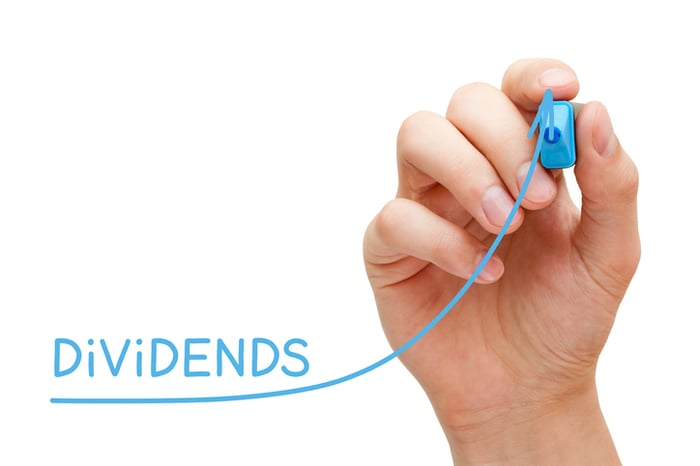There are great reasons to love dividend stocks. The passive income streams they generate make them an ideal fit for investors who want current income. And for those who don't need current income, reinvesting dividends can turn a relatively small investment into a sizable sum over the long term, thanks to the power of compounding.
Below we explore two dividend stocks that are currently yielding 4% or more, and while they're not risk-free, they shouldn't be as risky as most of their similarly high-yielding brethren.

Image source: Getty Images.
2 solid dividend stocks yielding more than 4%
|
Company |
Market Cap |
Dividend Yield |
Projected 5-Year Annualized EPS Growth* |
2020 Stock Return |
3-Year Stock Return |
|---|---|---|---|---|---|
| Innovative Industrial Properties (IIPR 1.08%) | $1.6 billion | 4.3% | N/A (135% this year; 156% next year) | 22.4% | 463% |
| Gaming and Leisure Properties (GLPI 0.94%) |
$10.5 billion | 5.7% | 10.9% | 14.4% | 92.4% |
| S&P 500 | -- | 1.72% | -- | 4.8% | 54.8% |
Data sources: Yahoo! Finance and YCharts. EPS = earnings per share. *Wall Street's consensus estimates. Data as of Feb. 12, 2020.
Innovative Industrial Properties has only traded since December 2016, which is why the three-year comparison was included in the chart, rather than a longer period, such as five or 10 years. It's worth noting that Gaming and Leisure Properties stock has beaten the market over the last half decade (it has not traded for a decade), returning 106% through Feb. 12, compared with the S&P 500's 79.2% return over this period.
Innovative Industrial Properties
Innovative Industrial Properties (IIP) is a cannabis sector-focused real estate investment trust (REIT). The company buys properties in U.S. states where medical marijuana is legal and leases them to state-licensed operators. IIP's focus is on industrial properties that are used for growing and processing cannabis. However, it's recently added several retail facilities (dispensaries) to its portfolio.
As of Feb. 12, IIP owned 47 properties located in 15 states. All of the properties -- 100% of them --are leased under long-term, triple-net leases. (Triple net means tenants pay for the big three variable costs of insurance, property taxes, and maintenance.)
IIP's attractive dividend yield stems largely from the company's organization as a REIT. In exchange for the special tax treatment they receive, REITs must distribute at least 90% of their taxable income each year as dividends to shareholders. That makes them an excellent group for investors to hunt among for dividend-paying stocks.
Investors should be getting material news soon. The company is slated to release its fourth-quarter and full-year 2019 results on Wednesday, Feb. 26, after the market closes. For the fourth quarter, Wall Street expects EPS of $0.57 on revenue of $14.4 million, representing growth of 138% and 200%, respectively, year over year.
Gaming and Leisure Properties
Gaming and Leisure Properties focuses on gambling. Management likely chose the broader name, however, because it has plans to eventually diversify beyond the gaming space.
Like IIP, Gaming and Leisure Properties is organized as a REIT. In late 2013, it was spun off from Penn National Gaming (PENN 0.49%), which operates casinos and racetracks in the United States. The company started its independent existence with 21 casino facilities, with all except two of them leased to Penn National under triple net leases. It operated those two itself. Since then, the company's portfolio has grown to include 44 gaming and related facilities across 16 states. It still operates the two casinos -- under the Hollywood Casino brand -- previously mentioned.
Along with Penn National, Gaming and Leisure Properties' tenants include Casino Queen, Eldorado Resorts, and Boyd Gaming.
In late 2018, the company acquired five casino properties from Tropicana Entertainment, giving it ownership of what's probably one of its best known properties, the Tropicana in Atlantic City, New Jersey.
The company is slated to release its fourth-quarter and full-year 2019 results on Thursday, Feb. 20, after the market closes. For the fourth quarter, Wall Street expects EPS of $0.53 on revenue of $288.2 million, representing bottom-line growth of 152% on a top-line decline of 5% year over year.
